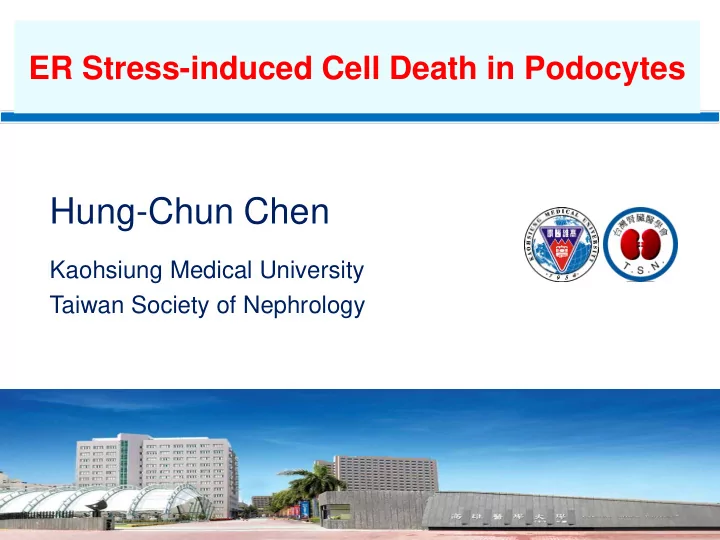

ER Stress-induced Cell Death in Podocytes Hung-Chun Chen Kaohsiung Medical University Taiwan Society of Nephrology 1
The Endoplasmic Reticulum (ER) 1. ER is a type of organelle in the cells of eukaryotic organisms that forms an interconnected network known as cisternae. 2. The endoplasm is the inner core of the cytoplasm and the membranes of the ER are continuous with the outer nuclear membrane. 3. There are two types of ER, rough and smooth. The outer (cytosolic) face of the RER is studded with ribosomes that are the sites of protein synthesis. The SER lacks ribosomes and functions in lipid manufacture and metabolism, the production of steroid hormones, and detoxification. 2
The Endoplasmic Reticulum (ER) 3
ER Stress/Unfolded Protein Response (UPR) 1. The unfolded protein response (UPR) is a cellular stress response related to ER. It is a stress response that has been found to be conserved between all mammalian species. 2. UPR is activated in response to an accumulation of unfolded or misfolded proteins in ER lumen. 3. UPR has three aims: initially to restore normal function of the cell by halting protein translation, degrading misfolded proteins, and activating the signaling pathways that lead to increasing the production of molecular chaperones involved in protein folding. 4. If these objectives are not achieved within a certain time span or the disruption is prolonged, the UPR aims towards apoptosis. 4
ER Stress/Unfolded Protein Response (UPR) 5
ER Stress and Cell Death 6
ER Stress Markers BIP / GRP78 ( Binding immunoglobulin protein / 78 kDa glucose-regulated protein) • chaperone • folding and assembly protein CHOP / GADD153 ( C/EBP homology protein / growth arrest and DNA damage-inducible gene153) • pro-apoptosis factor • trigger apoptosis 7
ER Stress in Kidney Diseases 1. Induction of ER stress in glomerular cells has been described in experimental models of membranous nephropathy and MPGN. 2. ER stress in glomeruli have been identified in various noninflammatory and inflammatory glomerulopathies in human kidney biopsies. 3. A tubulointerstitial ER stress response occur in glomerular diseases associated with proteinuria, including puromycin aminonucleoside nephrosis, protein overload, and experimental and human diabetic nephropathy.
Podocyte Response to Injury Kidney International (2008) 74, 22–36 9
ER Stress Increased Podocyte Cell Death TG & TM: ↑ ER Stress. Cheng & Chen, J Biochem 2015:158;101-108. 10
Albumin Increased ER Stress and Suppress Integrin- β1 ( One of the most important adhesion molecule for podocytes) Cheng & Chen, J Biochem 2015:158;101-108. 11
ER Stress Inhibitors (4-PBA & Sal) Reversed Albumin-induced Suppression of Integrin β1 •4-phenylbutyrate(4-PBA): •Salubrinal(Sal): Inhibit eif- 2α phosphatase Chemical chaperone Cheng & Chen, J Biochem 2015:158;101-108. 12
Antioxidant (NAC) Reversed Albumin- induced Suppression of Integrin β1 Chop GRP78 Cheng & Chen, J Biochem 2015:158;101-108. 13
Autophagy 1. Autophagy is a self-clearance or an execution mechanism for apoptosis and necroptosis (programmed necrotic cell death ). 2. Autophagy can be induced by ER stress, and various other cellular stresses, such as nutrient starvation or energy depletion. 3. The role of autophagy may be either protective or cytotoxic. Kidney International (2013) 84, 54–63 14
Autophagy • Basal autophagy is involved in the degradation of long-lived proteins and organelle turnover. mTOR 4. Breakdown and recycling 1. Induction 2.Autophagosome 3. Ducking formation and Fusion 15
ER Stress and Autophagy • ER stress (PERK/eIF2a phosphorylation) mediates the LC3 conversion and stimulates autophagy degrading the misfolded protein aggregates. 16 Cell Death and Differentiation (2007) 14, 230–239
ER Stress Induced Podocyte Autophagy (1) MDC stain: Specific for autophagic vacuoles CTL 6 h 24 h Tunicamycin Cheng & Chen, Exp Biol Med 2015:240;467-476.
ER Stress Induced Podocyte Autophagy (2) Tunicamycin Thapsigargin Ctl 1 6 12 24 48h Ctl 1 6 12 24 48h LC3 I LC3 I LC3II LC3II β -actin β -actin Cheng & Chen, Exp Biol Med 2015:240;467-476.
Rapamycin Promote Podocyte Autophagy and Decreased Apoptosis Rap+TM 24h Rap+Tg24h Rap TG24h TM 24h ctl Cheng & Chen, Exp Biol Med 2015:240;467-476.
3-methyladenine (3MA) Inhibit Podocyte Autophagy and Increased Apoptosis ctl 3MA TG24h TM 24h 3MA+TG24h 3MA+TM24h Cheng & Chen, Exp Biol Med 2015:240;467-476.
Inhibition of Autophagosome-lysosome Fusion by NH 4 Cl Increased Apoptosis ctl24h TG24h TM 24h NH4Cl+TG24h NH4Cl+TM24h NH4Cl Cheng & Chen, Exp Biol Med 2015:240;467-476.
Conclusion 1. ER stress may induce podocyte cell death. 2. Autophagy mediated to salvage the injuries caused by ER stress in short term. 3. We proposed that adequate, but not excessive, autophagy is crucial to help maintain the cell viability of podocyte. 22
Recommend
More recommend